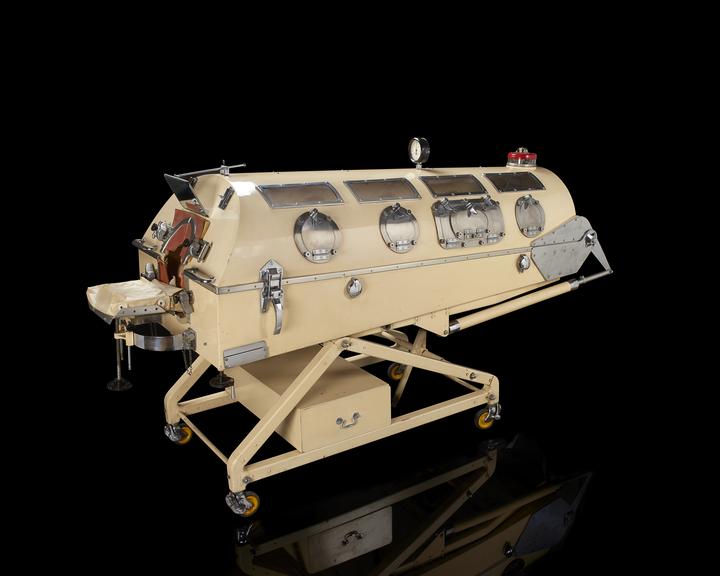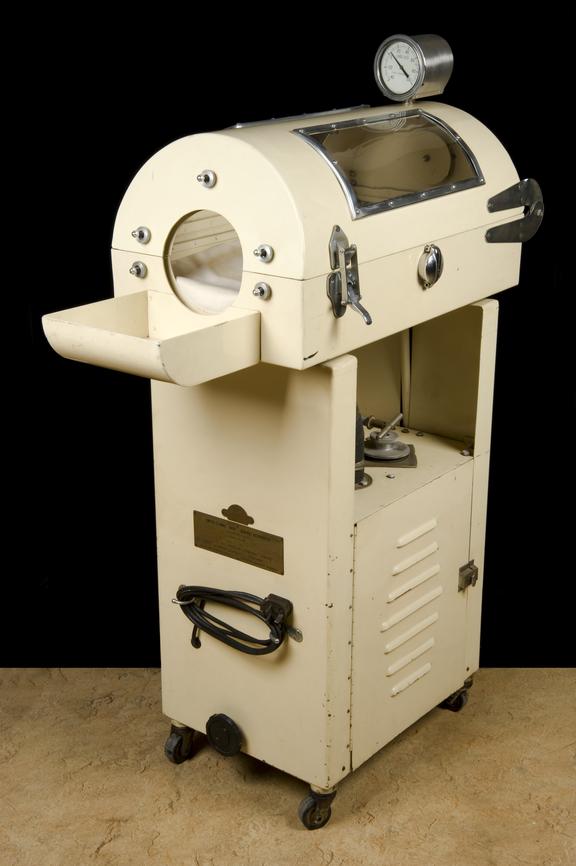It’s hard to believe that there are people who still depend on technology from decades ago to stay alive. Yet, this was exactly the case for Mona Randolph, an American woman who passed away in 2019 due to the long delayed effects of polio. She was able to use a wheelchair during the day but had to be put in her iron lung by night: “The ‘yellow submarine’ is my necessary, trusted, mechanical friend. I approach it with relief in store at night and thankfully leave it with relief in the morning.”
At the start of the twentieth century, but mostly in the 1940s and 1950s, polio, a disease that had been around for thousands of years, became an epidemic in the United States and Europe. The virus was mostly transferred through infected fecal matter that entered the body through the mouth and most of the people who got the virus had no symptoms or very minor symptoms. However, polio could also affect the spinal cord, which could cause muscle weakness and even paralysis. Between 2 and 10 out of the 100 people infected with polio who became paralyzed eventually passed away from complications that the virus caused.
If the polio-patient was paralyzed and couldn’t breathe on his own anymore he was, just like the COVID-19 patients of today, in need of a ventilator. This is where the iron lung comes into play. The iron lung was, like the name already suggests, an iron machine that helps the patient breathe via air pressure that builds up inside the machine. The patient would lay down inside the machine with their head poking out and a pump would regulate the air pressure inside the machine. If the air is pumped out it would cause a slight vacuum and that in it’s turn caused the patient’s chest to expand. To make the patient exhale the pressure inside the tube would be increased.
In the first place the iron lung was developed to treat gas inhalation victims. But in 1927 the iron lung was introduced and used for polio-patients. It was a lifesaving machine for them, because if they became paralyzed and couldn’t breathe on their own anymore, it would only be a matter of time before they would choke to death. When treating these types of patients, the iron lung would mostly be used until the patient regained their muscle strength and could breathe on their own again. Most of the time this would take around a couple of weeks, but it wasn’t out of the ordinary for it to take a couple of months. There were even patients who would never regain their muscle strength and had to rely on the iron lung for the rest of their lives. One of those people is Paul Alexander, an American man who has been dependent on his iron lung since he contracted polio in 1953.
The Science Museum in London has an iron lung on display. The ‘adult cabinet respirator’, as they call it, is on display in their Wellcome Galleries. The machine was made by Cape Engineering Company Limited in Warwick, England in 1953. It’s quite different than it’s predecessors because the so called ‘Drinker and Shaw tank’ was very heavy and also very expensive. The iron lung in the Science Museum looks more like a Both Portable Cabinet Respirator. This version of the iron lung was much cheaper, less heavy and it now contained several valves through which the body of the patient could be accessed must that be necessary.

But, the Science Museum doesn’t only have an adult version of the iron lung. They also own the so called ‘Smith-Clarke ‘Baby’ cabinet respirator’. Polio was a disease that was mostly contracted by children and babies, hence why there was a need for a special version of the iron lung for infants. Since polio was a disease that particularly affected children, lots of parents were very scared of it.
‘Everybody was petrified with the concept of polio. It kind of dominated the summer and parents were freaked out if their kid even got the sniffles.’
Paul Alexander, polio-survivor.

The iron lung was thought to be a great way of treating those with advanced polio because it was non-invasive. But the process of getting into the iron lung and receiving treatment was anything but a pleasant experience. Often the patients were already in a lot of pain and being put inside the tube was also quite a scary experience. Children often didn’t understand what was happening to them and why they had to be locked in the iron lung. Most people described it as either traumatic or just very boring. Since they couldn’t move their limbs and were locked in the machine, there wasn’t much to do. Sometimes the patients were put in front of a tv to entertain them, or with help of a nurse they could read a book if they turned the pages. At the height of the polio epidemic there were even whole hospital rooms all lined up with iron lungs so that the patients could at least talk to each other.
Luckily, the use of the polio vaccine helped to almost entirely eradicate the disease and the use for iron lungs dropped significantly with the introduction of positive pressure ventilation. With this method ventilators would blow air into the patients lungs via intubation. Even though iron lungs are a thing of the past, and the last people who actually still use iron lungs are approaching old age, it is still important to remember how many lifes were saved thanks to the machines. And especially with the COVID-19 pandemic still not behind us, it’s very interesting to see how we dealt with pandemics and viruses in the past.
Lotte Jellema